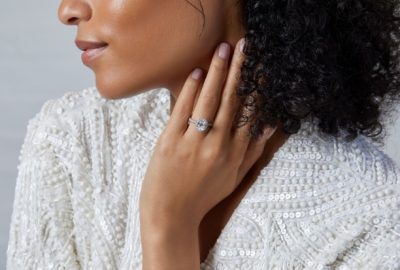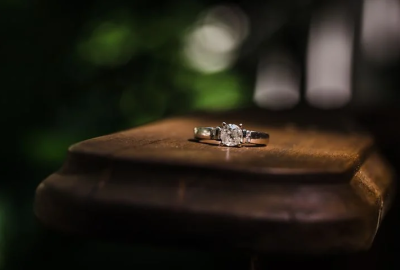Buying an engagement ring is a big purchase – you’ll be wearing this beautiful piece day in day out, plus, you’ll probably spend considerably more on it than any other piece of jewellery you’ll ever buy so it defo needs a bit of thought! While an engagement ring may look pretty, there’s a few things you need to think about before you put down that deposit. Today we’re joined by Eric from McGuire Diamonds who has some useful tips for buying a diamond engagement ring so you’re armed with the right info before you go shopping. Over to Eric…
1. Diamond Education
Diamond education, this is by far the most important tool you will need to have before shopping begins. Diamonds have always been regarded as an investment and unless you educate yourself about what you are buying, your investment may suddenly become an expensive mistake. You wouldn’t dream of purchasing a car or a house without first doing a little research, apply this to your diamond search also. Once you are armed with the knowledge that is necessary to make an educated decision the rest will be an enjoyable experience.
2. The Cut
The first ‘C’ to think about when choosing a diamond is the cut. The cut determines the shape of the diamond as well as its brilliance, because different cuts have differing numbers of facets, and it’s these facets that give the diamond its sparkle. Think of facets like reflective surfaces that shine light through the diamond.
There are many different diamond cuts to choose from, so I would like to explain the most important points for each one. The round brilliant cut is the most popular cut for engagement rings because it gives a nice shape on the hand, and it has a lot of brilliance as well, thanks to its 57 facets.
The oval shape is in fact a variant of the brilliant cut, so it has lots of brilliance and sparkle, but it suits petite hands a little bit better.
The pear shape is a really feminine cut, and it works beautifully on petite hands. Because it’s got the pointed end, it has the effect of elongating the fingers.
The antique style of the cushion cut has gained favour in the past few years, it has that nice combination of a very precise, modern cut, but with an of old-fashioned air about it.
Our personal favourite has to be the emerald cut, because it is very traditional with its beautiful long, clean lines and a deep shine as opposed to a brighter sparkle. We think the emerald cut suits a larger hand with long fingers.
Once you’ve decided the cut of the diamond, it’s really important that you make sure that you buy a good-quality cut, because it’s the precision of the cut that determines how much brilliance you will get from a diamond. At McGuire Diamonds we only sell cuts that are from excellent to good, which means that you are making the very most of that investment.
3. Clarity
The second ‘C’ is for clarity, and this refers to how clean or clear the diamond is. It goes a lot more than just skin deep. To determine how clean a diamond is, you’ll need a jeweller’s loop, and this magnifies by ten times, so any grading that you find on a diamond certificate refers to what is visible with a magnification of ten times.
The flaws that occur in a diamond have two names, if they are inside the diamond, they are called inclusions, and if they are on the surface, they are called blemishes, so you need to look out for those two different types. Inclusions are more visible in some cuts than others, and the most forgiving cut for inclusions is the cushion cut, whereas the emerald is quite the opposite, and its long, clean lines that shine right into the heart of the diamond mean that there is no room for any flaws.
The clarity of a diamond is graded on a scale, right at the bottom is imperfect, and it goes to the top grading, which is flawless; the most desirable. This is of course determined by how many blemishes or inclusions are within that diamond.
After internally flawless comes VVS, which stands for very, very slightly included, then just after that is VS, which stands for very slightly included. McGuire Diamonds only sells the very best quality, we will not go below VS – very slightly included – so use that as a benchmark; don’t go below VS1 or 2 if you can avoid it.
4. Colour
Another important ‘C’ to consider when buying a diamond is colour, and if it’s a white diamond, ironically what you’re looking for is total lack of colour. The top grading for a white diamond is D, it goes down alphabetically right to Z.
The way that they decide on the grading for the colour of a diamond is to look at it upside down, so that eliminates the sparkle factor, against white paper, then they check that against a chart of colours, so it’s all scientific and it’s determined by an expert.
If you’re considering buying a single-stone ring, the general recommendation here at McGuire Diamonds is to not go below G colour, because any point below that, then you do start to get a slightly less clear white colour.
5. The Carat
Carat refers to the weight of the stone, and one carat is one fifth of a gram. Obviously a large diamond is more valuable than a small diamond, but it is interesting to know that large diamonds are of course rarer, so this means that a five-carat diamond is many times more valuable than a one-carat diamond; it isn’t simply five times more valuable.
Not all diamond cuts look the same size even if they are the same carat weight, and a brilliant cut is the one that punches above its weight because of its diameter; it looks bigger than a similar-carat emerald cut. If you’re going for the big look on the finger, the brilliant cut will do it every time.
6. Certification
McGuire Diamonds advocate a fifth C, Certification, this important C is sometimes forgotten or ignored completely. A certificate is an unbiased assessment of a diamond’s quality and value. During certification, a diamond’s carat weight is measured, clarity is assessed, the colour and cut are graded, if the stone contains fluorescence this will be noted also (the less fluorescence the more valuable the diamond is). When we discuss certification we refer to certification from a trusted laboratory, this is why at McGuire Diamonds we only use diamonds certified by HRD and GIA. These are the two most highly respected independent grading laboratories in the diamond industry. We found this link to be very honest and insightful.
7. Set Budget & Shop Around
Decide on your budget and stick to it! Shop around, online is a good place to start to get a sense of what your budget will allow you to purchase. Always remember to compare like with like when shopping around, ask the retailer to write down all the relevant details; carat weight, cut, colour and clarity as well as the price so that you can make a proper comparison.
8. Choose Your Jeweller Wisely
Finally, choose your jeweller carefully, in the same way that you would choose your mechanic or your doctor. Ask around, look for recommendations and read reviews online.
Dubai and Antwerp seem to be popular engagement ring destinations these days, people travel to these destinations due to articles they have read online. Beware of misleading marketing, people are paid to produce articles online about the value in such destinations, it’s their job, and with large marketing budgets behind these articles they can seem true. At McGuire Diamonds we often have customers looking for valuations for rings bought abroad and most are disappointed when they hear the true value of the item they have purchased. Remember the golden rule; if it’s too good to be true it generally is!
Photo from Rana & Andrew’s wedding by The Fennells


